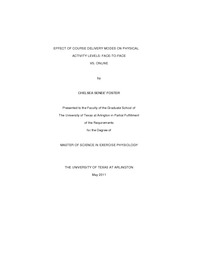
ATTENTION: The works hosted here are being migrated to a new repository that will consolidate resources, improve discoverability, and better show UTA's research impact on the global community. We will update authors as the migration progresses. Please see MavMatrix for more information.
Show simple item record
| dc.contributor.author | Foster, Chelsea | en_US |
| dc.date.accessioned | 2011-07-14T20:54:14Z | |
| dc.date.available | 2011-07-14T20:54:14Z | |
| dc.date.issued | 2011-07-14 | |
| dc.date.submitted | January 2011 | en_US |
| dc.identifier.other | DISS-11112 | en_US |
| dc.identifier.uri | http://hdl.handle.net/10106/5854 | |
| dc.description.abstract | The purpose of this study was to determine physical activity levels in students enrolled in a walk/jog class that was delivered online and in a traditional face to face environment. Differences in voluntary exercise intensity and duration between the two delivery modes were examined as they specifically related to fulfilling the course requirements. Overall activity levels were determined for a 7 day period. Forty-three college students [mean (±SD) age: 24.7 ± 8.2 years; height: 65.7 ± 3.5 in; weight: 73.5 ± 17 kg] enrolled in a walk for fitness or walk for fitness class at the university level volunteered for the study. Subjects enrolled at the time of the study in an online or face-to-face section of walk/jog for fitness were recruited and classified into one of two groups [online group (n=18) and an on campus group (n=25)] based on their enrollment status. The subjects wore the accelerometer for a seven-day period and wore the polar heart rate chest strap only when they participated in their exercise for their designated class. There was no significant difference in the amount of MVPA between the groups related to fulfilling the requirements of the course. A purposeful bout of exercise lasted 34.1 ± 10.4 minutes in the face-to-face class and 36.2 ± 21.3 minutes in the online class. Interestingly when the entire day was examined and not just class time, significant difference between the two groups existed on the amount of moderate to vigorous physical activity they achieved on a class day (p=0.034) with online getting 114.5 ± 94.5 minutes of MVPA and on campus getting 173.4 ± 80.5 minutes of MVPA. However, there were no significant differences between groups in their total week, during class, or non-class day spent in the moderate to vigorous range of physical activity. However both groups got significantly more physical activity on days they were fulfilling the course requirements (non-class day vs. class day). | en_US |
| dc.description.sponsorship | Buckwalter, John | en_US |
| dc.language.iso | en | en_US |
| dc.publisher | Kinesiology | en_US |
| dc.title | Effect Of Delivery Modes On Physical Activity Levels: Face-to-face Vs. Online | en_US |
| dc.type | M.S. | en_US |
| dc.contributor.committeeChair | Buckwalter, John | en_US |
| dc.degree.department | Kinesiology | en_US |
| dc.degree.discipline | Kinesiology | en_US |
| dc.degree.grantor | University of Texas at Arlington | en_US |
| dc.degree.level | masters | en_US |
| dc.degree.name | M.S. | en_US |
Files in this item
- Name:
- Foster_uta_2502M_11112.pdf
- Size:
- 1.607Mb
- Format:
- PDF
This item appears in the following Collection(s)
Show simple item record


